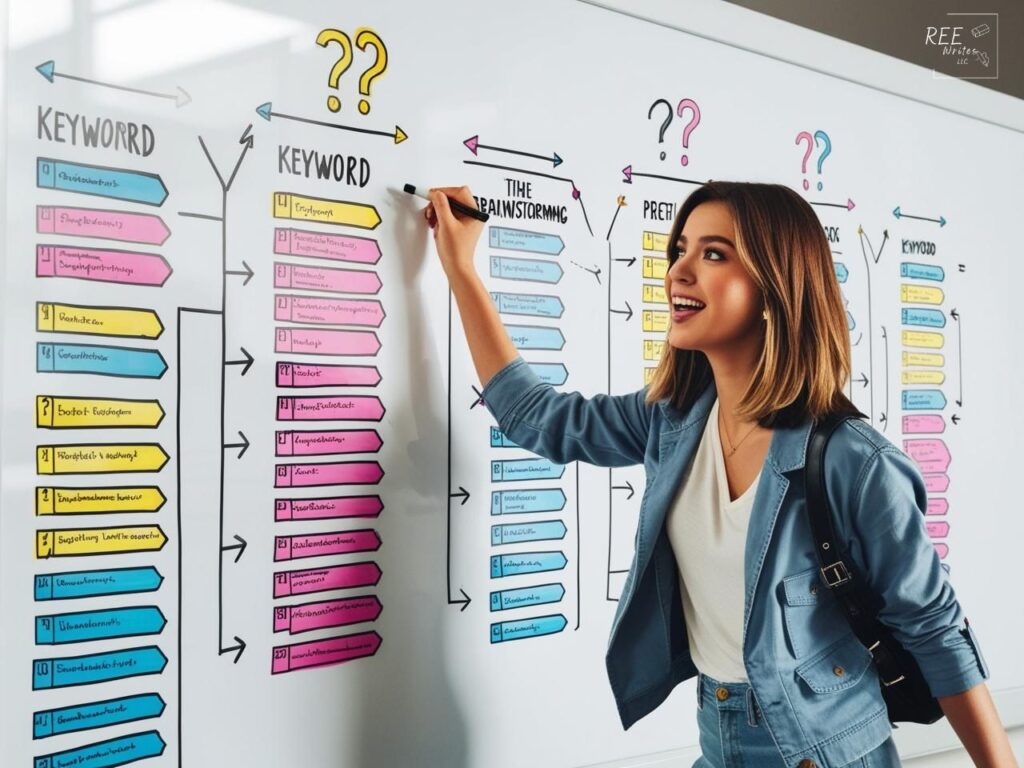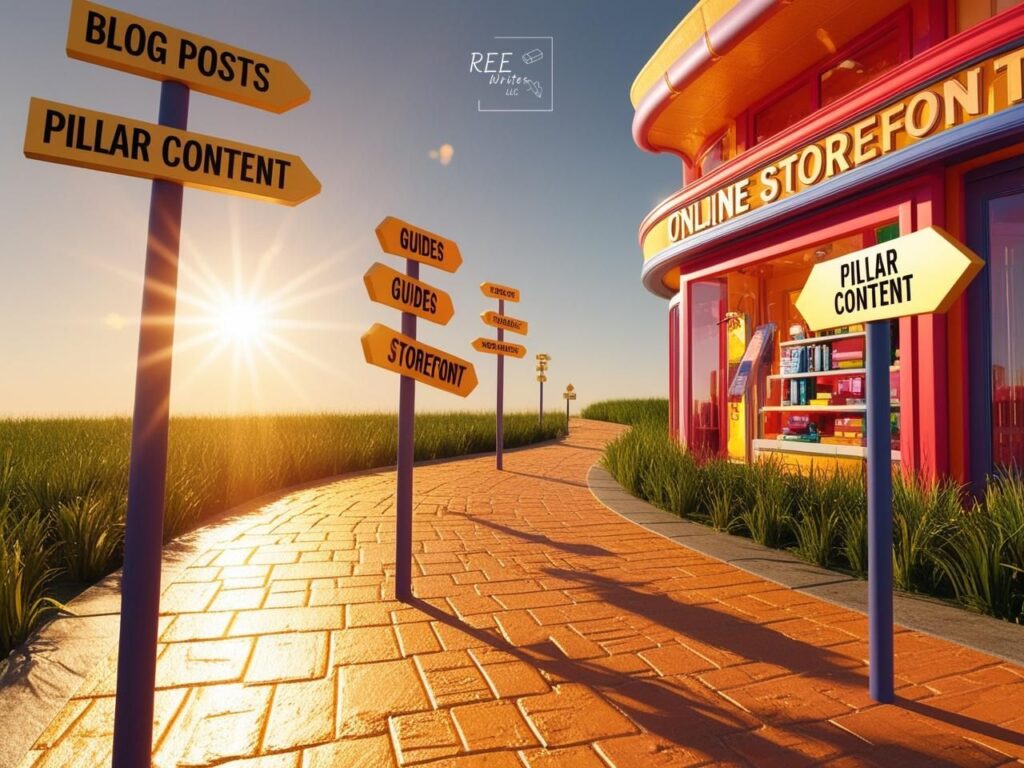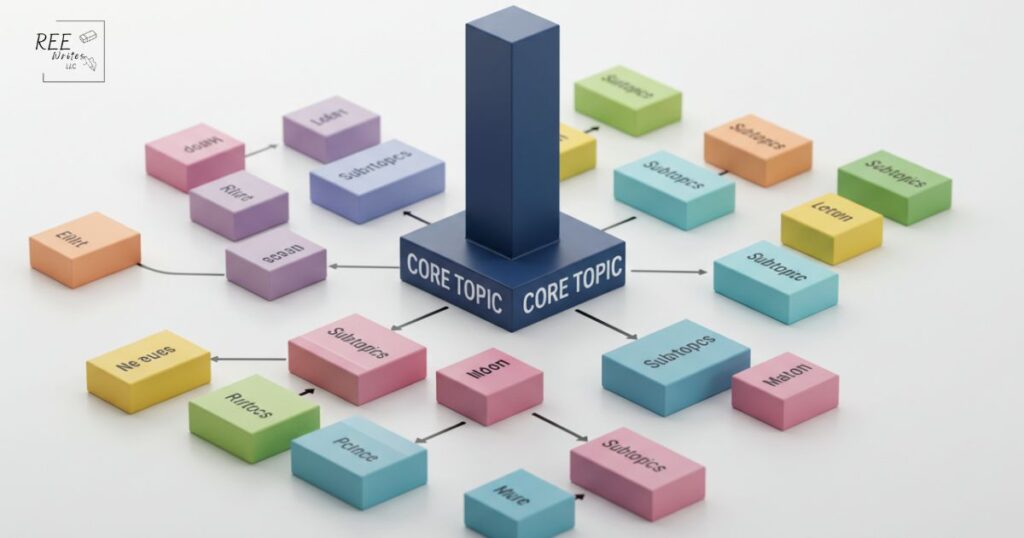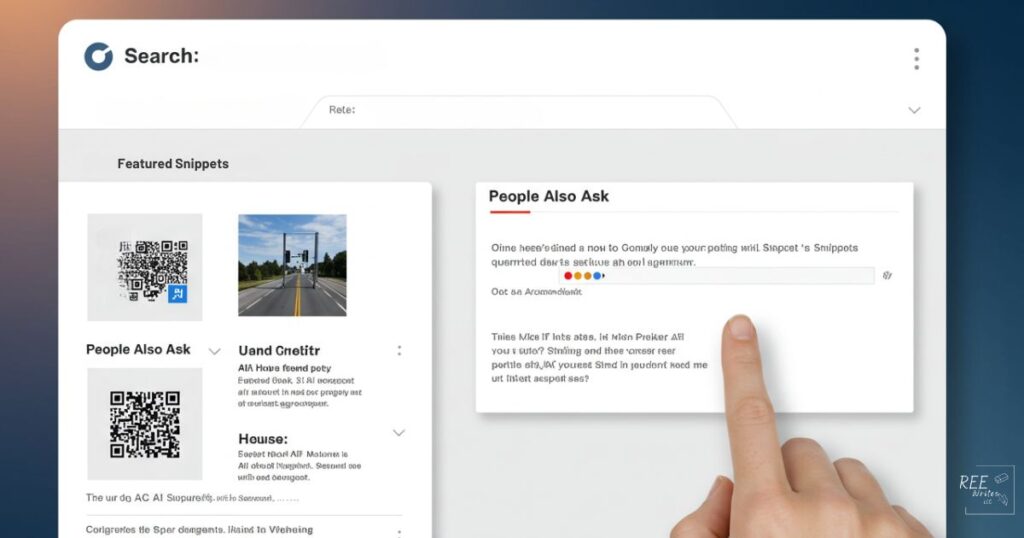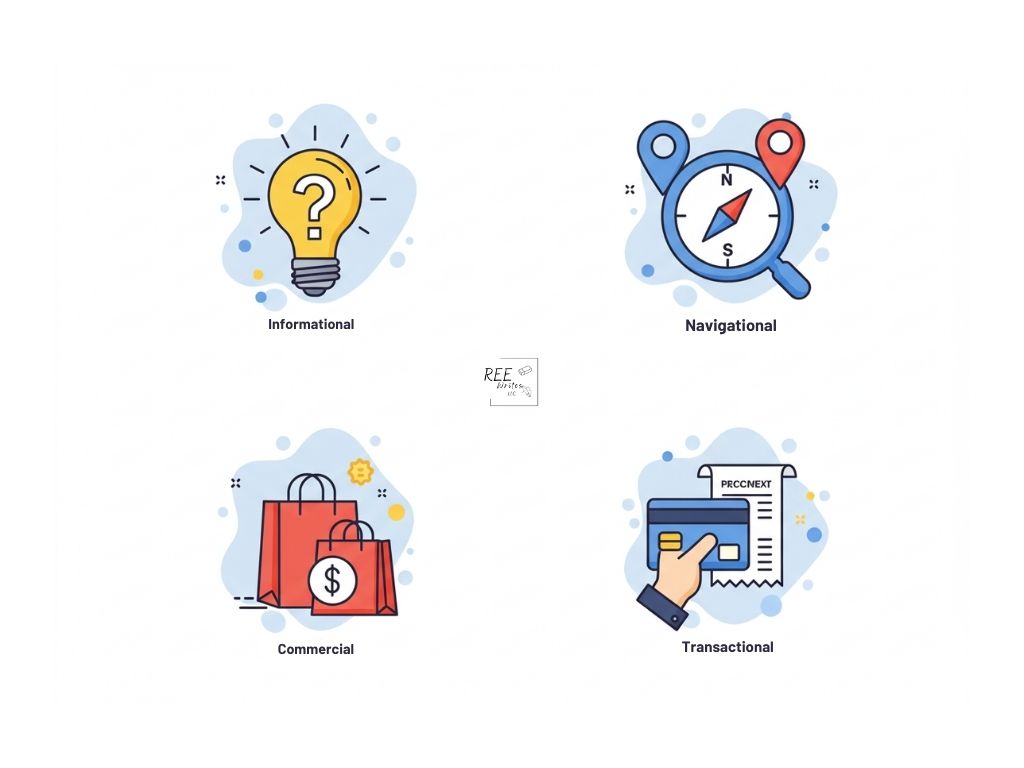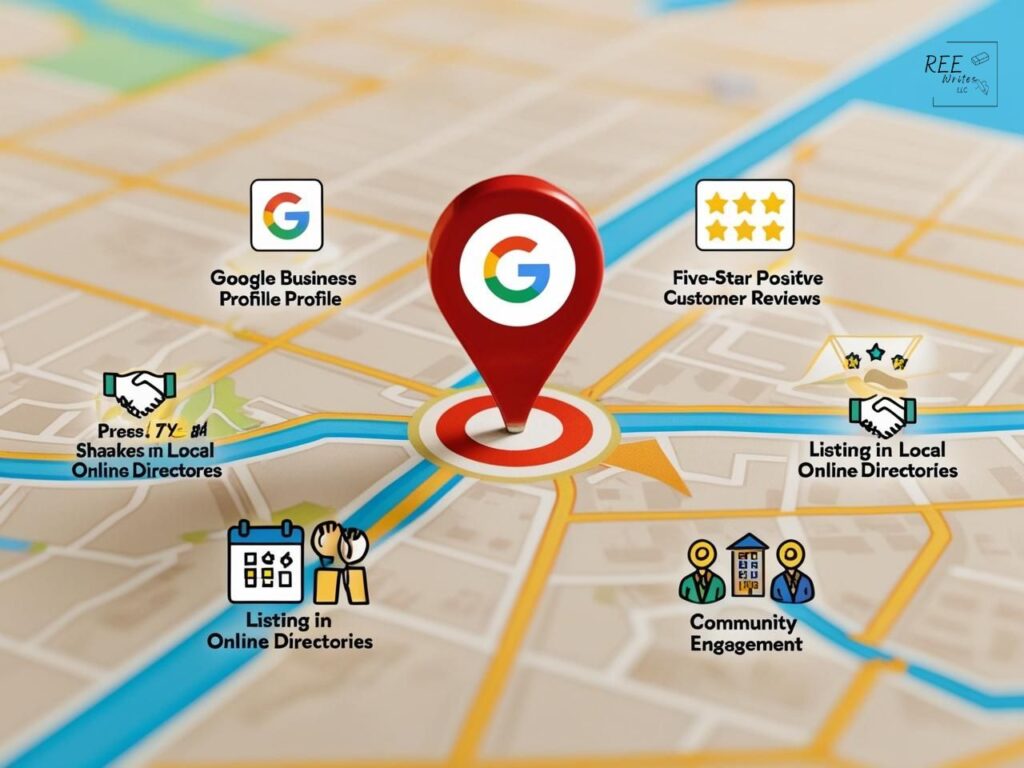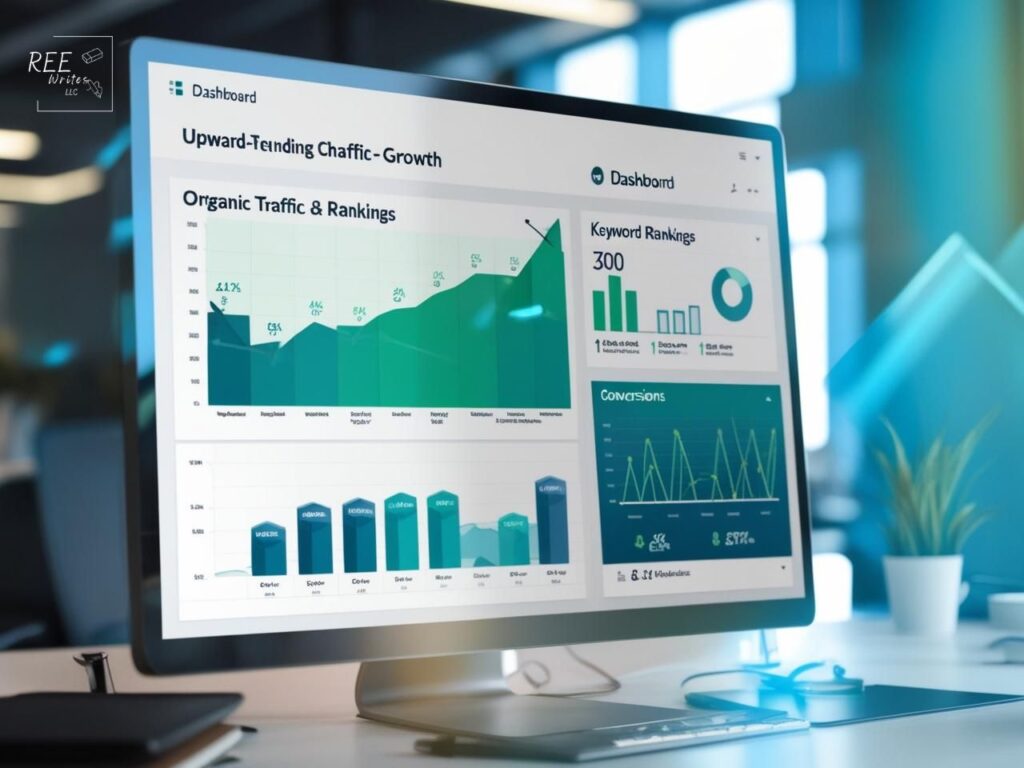Do you ever feel like you’re caught in a tug-of-war with your content? 55% of B2B marketers and content creators struggle to create content. Part of that struggle is finding a balance SEO requirements with creative expression. It’s normal to feel torn between pleasing search engines and connecting with real people by writing something fresh, engaging, and authentically you (or your business).
Well, you don’t have to choose. Creating SEO-friendly creative content isn’t about sacrificing your voice for rankings. It’s about finding a smart way to satisfy both.
Let’s go through some practical strategies and techniques to craft content for good SEO, while still satisfying your audience—not boring them.
Contents
- SEO and Creativity Are Not Enemies
- Understand User Search Intent Before You Write
- Informational intent (I want to know)
- Navigational intent (I want to go)
- Commercial intent (I want to compare before doing)
- Transactional intent (I want to do/buy)
- Use keyword modifiers as clues
- Analyze the SERPs (Search Engine Results Pages)
- Check "People Also Ask" (PAA) and related searches
- Leverage keyword research tools with intent labels
- Keyword Research for Creative Minds
- Use question-based keywords for content inspiration
- Explore long-tail keywords for specific creative angles
- Look at related keywords and "People Also Search For" (PASF) for thematic depth
- Search semantic and LSI keywords
- Identify related terms and entities
- Organize keywords into topic clusters
- Use clusters to guide creative content planning
- Smart, Natural Keyword Placement
- Good Structure and Formatting for Bots and People
- Writing Techniques That Boost SEO Without Killing Your Voice
- Tools That Support Both SEO and Creative Writing
- Strike the Right Chord with SEO and Creativity
SEO and Creativity Are Not Enemies

There’s a myth floating around that SEO forces writers into creating dull, robotic content stuffed with keywords. Maybe you’ve heard that SEO kills creativity, turning vibrant writing into formulaic text designed only for machines.
But actually, search engines have gotten much smarter. They’re no longer just looking for keywords; they’re looking for content that genuinely helps people by focusing on user intent (the info a person is looking for online).
Think about it: what makes content great for readers? Often, it’s creativity! A unique perspective, an engaging story, a clear explanation with helpful visuals – these creative elements keep people on your page longer, encourage them to explore more, and even prompt them to share your content. These are known as engagement metrics, and they matter for SEO.
Search engines reward authentic, valuable content

Authenticity isn’t just nice to have; it’s becoming an SEO advantage. Modern search algorithms enhanced by AI prioritize understanding context, user intent, and overall content quality.
Google explicitly states its systems aim to reward original, high-quality, people-first content demonstrating Expertise, Experience, Authoritativeness, and Trustworthiness (E-E-A-T). This means content that offers real value for humans, answers their questions thoroughly, and comes from a place of genuine experience or expertise, is more likely to rank well.
Google’s “Helpful Content Update” specifically targets content written primarily for search engines instead of humans. This system rewards content that provides a satisfying user experience (UX) and demonstrates first-hand experience or deep knowledge.
Creative approaches improve engagement metrics

When you use creative techniques like storytelling, compelling visuals, or interactive elements, you make your content more engaging. This isn’t just good for the reader; it sends positive signals to search engines.
Metrics like average engagement time (how long people stay on your page), engagement rate (the percentage of visits with meaningful interaction), and lower bounce rates (people leaving after viewing only one page) indicate that users find your content valuable. Search engines interpret these signals as signs of quality content that satisfies user intent.
According to Contentsquare’s 2024 Digital Experience Benchmarking Report, poor page interaction (measured by Interaction to Next Paint or INP) reduces engagement by -11.7%. Creative, engaging content naturally improves interaction and keeps users on the page longer. Longer average engagement time suggests users find your content valuable.
Brands who successfully balance SEO and creativity
Many successful brands prove that SEO and creativity can coexist and thrive. They create content that’s not only optimized for search but also genuinely interesting, helpful, and reflective of their unique brand voice. Some examples include:
- Flyhomes: Achieved massive organic growth (over 1.1M monthly visits) by creating comprehensive, data-rich cost of living guides. This balanced a creative approach to a common user need (housing information) with strong SEO content strategy.
- Brainly: Leveraged user-generated content (questions and answers) to create millions of unique pages targeting long-tail keywords, tripling their keyword rankings by fostering a creative, peer-to-peer learning environment.
- ZOE: Focused on optimizing creative visual content (images) with descriptive alt text and filenames, resulting in 72.1K image snippets and significant organic growth by making their unique visual health insights discoverable.
- Liquid Death, CeraVe, E.L.F. Cosmetics: These brands demonstrate the power of a “social-first” brand building approach, often involving creative, engaging content that resonates with communities, which can indirectly boost SEO through increased visibility and brand mentions.
These examples show that focusing on user needs with creative execution, supported by smart SEO, is a winning formula.
Next, let’s look at the first crucial step before you even start writing: understanding why someone is searching in the first place.
Understand User Search Intent Before You Write
Before you pour your creative energy into a piece of content, you need to know why someone would search for your topic. What are they really trying to achieve? The “why” behind a search query is called search intent or user intent.
Understanding search intent is critical because Google’s #1 goal is to provide users with the most relevant results that satisfy their underlying need. If your creative masterpiece doesn’t match the searcher’s intent, it’s unlikely to rank well, no matter how brilliant it is.
There are four main types of search intent:

Four Types of Search Intent
| Intent Type | Definition (What the user wants) | Example Keywords/Indicators | Best Content Types |
|---|---|---|---|
| Informational | To learn something, find answers, get explanations, or guidance | “how to,” “what is,” “why,” “guide,” “tips,” question words | Blog posts, guides, tutorials, infographics, videos, FAQs, explainers |
| Navigational | To find a specific website, brand, or page | Brand names (“Nike”), specific site terms (“Instagram login”) | Official website homepage, specific product/service pages, login pages, brand profiles |
| Commercial Investigation | To compare options, research products/services before buying | “best,” “top,” “vs,” “review,” “comparison,” “alternatives” | Comparison articles, reviews, listicles, buyer’s guides, case studies, testimonials |
| Transactional | To complete an action (buy, sign up, download, find location) | “buy,” “discount,” “coupon,” “price,” “order,” “near me,” product names | Product pages, service pages, e-commerce category pages, pricing pages, sign-up forms |
Knowing which intent you’re targeting helps direct your creative approach.
Informational intent (I want to know)

Users with informational intent are looking for knowledge. They may be asking “how to fix a leaky faucet,” “what are the benefits of meditation,” or “history of the Eiffel Tower.”
Your creative challenge here is to present information clearly, engagingly, and comprehensively. Think step-by-step guides, insightful explainers, helpful tutorials, or visually appealing infographics (linkable assets).
Informational searches make up the largest chunk of queries. SparkToro/Datos suggests 52.65% of Google searches are informational. Another source suggests it could be as high as 70%.
Navigational intent (I want to go)
Here, the user already knows the destination – a specific website or brand. They may search for “YouTube,” “Amazon login,” or “Backlinko blog.”
This isn’t the place to get creative, because the goal is to ensure your official pages (homepage, login page, key product pages) are easy to find. Your creativity can focus on clear branding and UX on those specific pages.
Navigational searches are also significant, with data indicating 32.15% of Google searches fall into this category.
Commercial intent (I want to compare before doing)
These users are in the research phase before making a purchase or commitment. They’re comparing options, looking for reviews, and trying to find the best fit.
Searches may include “best running shoes for beginners,” “Surfer SEO vs Clearscope,” or “Mailchimp alternatives.” Your creative opportunity lies in providing persuasive, helpful comparisons, in-depth reviews, detailed case studies, or compelling testimonials.
Commercial intent searches represent the crucial middle-of-the-funnel stage, at 14.51% of Google searches.
Transactional intent (I want to do/buy)

Users with transactional intent are ready to act. They’re looking to “buy noise-canceling headphones,” find “pizza delivery near me,” or get a “free trial for project management software.”
Creativity here focuses on clear calls-to-action (CTAs), persuasive product descriptions, easy checkout processes, and highlighting value propositions like discounts or free shipping.
While purely transactional searches may seem low (0.69% according to SparkToro/Datos), many commercial searches lead directly to a transaction. Optimizing product and service pages for this intent is vital for conversions.
Understanding these types is the first step. But how do you figure out the intent behind your specific keywords?
Use keyword modifiers as clues
Often, the words used in the search query itself hint at the intent.
- Informational: “how,” “what,” “why,” “guide,” “tips,” “learn”
- Commercial: “best,” “top,” “vs,” “review,” “comparison,” “alternatives”
- Transactional: “buy,” “order,” “discount,” “coupon,” “price,” “deal,” “near me”
- Navigational: Brand names, specific product names
While titles with question-based keywords may have a slightly lower click-through rate (CTR) overall (15.5% vs 16.3% for non-question titles), they are strong indicators of informational intent.
Analyze the SERPs (Search Engine Results Pages)

The best way to determine intent is to Google your primary keyword (also known as a target or focus keyword) and look at the results on the first page. What kinds of pages are ranking?
- Are they mostly blog posts and guides? (Informational)
- Are they product pages from online stores? (Transactional)
- Are they comparison articles and review sites? (Commercial)
- Is it the brand’s official homepage? (Navigational)
- Which SERP features appear? Featured snippets suggest informational intent, while shopping ads or local map packs point towards transactional or local intent.
Moz observed that searching “blender” brings up mixed results (the software and the kitchen appliance), indicating Google isn’t sure of the primary intent. However, searching “coffee maker” predominantly shows e-commerce category pages, clearly signaling commercial or transactional intent.
Check “People Also Ask” (PAA) and related searches

The PAA boxes directly show questions users are asking related to your keyword. These questions are a goldmine for understanding specific informational needs or comparison points. Similarly, the “Related searches” section at the bottom of the SERP shows how users refine or continue their search, offering clues about their ultimate goal.
If you search “best email marketing tools,” the PAA section may include questions like “What is the #1 email marketing tool?” or “Which email platform is best for small business?” This clearly signals users are in a commercial investigation phase, comparing options.
Leverage keyword research tools with intent labels
Many SEO tools can save you time, as they automatically categorize keywords by search intent, such as Moz Pro, Semrush, Ahrefs, seoClarity, and various AI platforms. However, always double-check the SERPs yourself, especially for keywords that could have mixed intent.
For instance, using Moz Pro’s Keyword Suggestions, you can see that the tool identifies “coffee maker” as having high commercial intent, confirming the manual SERP analysis.
By understanding the why behind the search, you can tailor your creative approach to meet that specific need, making your content far more effective for both users and search engines.
With a clear understanding of user intent, how do you find the actual words and phrases your audience uses? The answer is keyword research.
Keyword Research for Creative Minds
Often, keyword research gets a bad rap among creative types. It can feel like a purely technical, data-driven chore that stifles creativity. But what if we reframed it? Think of keyword research not as a restriction, but as a powerful tool for audience insight.
Keywords are the actual words and phrases your potential readers use when they’re looking for information, solutions, or inspiration online. Understanding these terms helps you:
- Know the language your audience speaks.
- Identify their specific questions and pain points.
- Discover content topics they’re actively interested in.
- Find angles that resonate with their needs.
Approached this way, keyword research becomes a source of creative inspiration, not a barrier to it.
Use question-based keywords for content inspiration

Keywords phrased as questions (starting with “who,” “what,” “where,” “when,” “why,” or “how”) are direct lines into your audience’s minds. They explicitly state the problem or information gap the user is trying to fill.
Each question is a potential blog post, video topic, or section within a larger guide. Tools like AnswerThePublic or simply analyzing the PAA boxes in Google search results are great ways to find these.
While only about 8% of searches are phrased as questions, these queries often have clear intent, making them valuable targets for focused, creative content that provides direct answers.
Explore long-tail keywords for specific creative angles

Long-tail keywords are longer, more specific phrases, typically three or more words. Think “easy vegan weeknight dinner recipes” instead of just “vegan recipes.” Because they’re specific, they usually have lower search volume but also less competition and much clearer intent.
These niche queries are perfect for sparking targeted, creative content ideas. They often reflect conversational language used in voice search, which is increasingly common.
Long-tail keywords account for 70% of all search traffic, and 10 to 15 words get 1.76 times more clicks than single-word queries, indicating users find specific queries yield more relevant results.
Look at related keywords and “People Also Search For” (PASF) for thematic depth

When you research a primary keyword (also called a focus keyword), tools and Google itself will show you related terms and topics. Google’s “Related Searches” (or “People Also Search For”) section shows what users search for next.
Exploring these related areas helps you understand the broader context around your topic and identify adjacent themes your audience cares about. This allows you to create a richer, more comprehensive (and creative!) exploration of a subject, rather than just a single, narrow piece.
Researching “how to start a podcast” may reveal related searches like “podcast equipment for beginners,” “podcast hosting platforms,” “how to monetize a podcast,” and “podcast interview techniques.” Each of these could become a separate creative content piece supporting the main topic.
Search semantic and LSI keywords

Modern search engines like Google don’t just match keywords; they understand meaning and context, which is called semantic search. They recognize synonyms, related concepts, and the relationships between words. Latent Semantic Indexing (LSI) keywords are terms conceptually linked to your main topic.
Using these related terms helps Google grasp the full meaning of your content and allows you to write more naturally and creatively without awkwardly repeating your main keyword.
Because Google understands semantics, using varied language and explaining concepts in different ways actually helps your SEO by providing richer contextual clues. This directly rewards creative expression in writing.
Identify related terms and entities

Go beyond simple keywords and identify the main entities (people, places, organizations, concepts) associated with your topic.
Also, actively look for synonyms and related phrases by using SEO tools, analyzing top-ranking content, or simply brainstorming related ideas. Weaving these terms and entities naturally into your writing adds semantic depth and demonstrates comprehensive understanding.
For example, if your content is about “sustainable travel,” related terms may include “eco-tourism,” “carbon offsetting,” “responsible travel,” “low-impact accommodation.” Related entities could be “Greta Thunberg,” “Costa Rica” (as a destination known for eco-tourism), “WWF,” or specific eco-lodges.
Organize keywords into topic clusters

A powerful way to structure your content strategy is using topic clusters. This involves choosing a broad “pillar” topic and creating a comprehensive central page about it. Then, you create multiple “cluster” pages that cover specific subtopics related to the pillar in more detail.
All these pages are linked together internally. Grouping your researched keywords into these clusters helps you plan content systematically.
Topic clusters provide a framework that supports creativity. The pillar page establishes the foundation, while the cluster pages allow you to explore specific angles using diverse creative formats (videos, infographics, deep-dive articles, case studies). This structure also signals topical authority to Google, boosting your credibility and rankings.
Use clusters to guide creative content planning

Once you’ve grouped your keywords into clusters, use this structure as a roadmap. Plan out your pillar content and the supporting cluster content.
Decide which creative formats best suit each subtopic based on its specific keywords and user intent. This ensures you cover the subject comprehensively while keeping your content organized and interconnected. Use keyword clustering tools (which group keywords based on semantic meaning or shared SERP results) to help automate this grouping process.
Building content around topics where your website demonstrates expertise and trustworthiness (Topic Authority) can significantly improve your search rankings. Topic clusters are key to building and showing your authority.
Okay, you’ve got your intent figured out and a list of keywords that actually spark some creative ideas. How do you weave those keywords into your writing and still sound human?
Smart, Natural Keyword Placement
The goal here is simple: integrate keywords seamlessly so they support the reader’s journey, not interrupt it. Forget about “keyword density” percentages and focus on natural language. Keyword stuffing (jamming keywords in unnaturally) creates a terrible reading experience and can get your site penalized by search engines.
Instead, focus on placing your keywords strategically in key areas where they have the most impact for both readers and search engines, always prioritizing clarity and flow.
Include keywords in your title tag

Your page’s title tag (the clickable headline shown in search results) is prime real estate. It’s a strong signal to search engines about your page’s topic and heavily influences whether users click.
Try to place your primary keyword near the beginning of the title tag, but only if it sounds natural and accurately reflects the content. Keep it concise (under 60 characters is a good guideline) and compelling.
Google often rewrites title tags if they’re too long, stuffed with keywords, or don’t seem to match the content’s intent well. A clear, relevant title tag that includes the keyword naturally has a better chance of being displayed as you intended.
Weave keywords into headings and subheadings
Headings (H1, H2, H3, etc.) break up your text and create a clear structure, making it easier for readers to scan and understand the content. They also help search engines understand the hierarchy and main points of your page.
Use your primary keyword in your main title (H1) using a conversational tone. Incorporate variations or related keywords into your subheadings (H2s, H3s) where they fit logically and describe the section’s content accurately.
Good heading structure directly improves UX by making content readable and scannable. When users can quickly find the information they need, they’re more likely to stay engaged – a positive signal for SEO.
Place keywords early in your introduction
Include your primary keyword somewhere in the first paragraph, or at least within the first 100 to 150 words of your content. This immediately confirms the topic for your audience and search engines, which shows its relevance right from the start.
For example, if your article targets “mindfulness techniques for stress,” your introduction could start with: “Feeling overwhelmed? Discover simple mindfulness techniques for stress reduction that you can practice anywhere…”
Integrate keywords naturally within the body content

Sprinkle your primary keyword, along with synonyms and related terms (semantic keywords), throughout the main body of your text. Don’t obsess over frequency or density; focus on whether the language sounds natural and makes sense in context. If a sentence sounds awkward with the keyword, rephrase it or use a variation.
Use keywords in URLs
Your page’s web address (URL) is another place to include your primary keyword, if possible. Keep URLs short, descriptive, and use hyphens (-) to separate words (yourwebsite.com/seo-friendly-creative-content).
A clear URL helps users and search engines understand the page topic at a glance. Pages with the primary keyword in the URL tend to have a 45% higher click-through rate from search results.
Optimize meta descriptions with keywords

The meta description is the short snippet of text that appears under your title tag in search results.
For this article, a meta description could be: “Learn proven techniques to create SEO-friendly content while maintaining your creative voice. Boost rankings without boring readers.”
While it’s not a direct ranking factor, it heavily influences whether someone clicks on your link. Write a compelling description (around 155 characters or less) that accurately summarizes the page and includes your primary keyword naturally. Think of it as ad copy for your content.
Add keywords to image file names and alt text
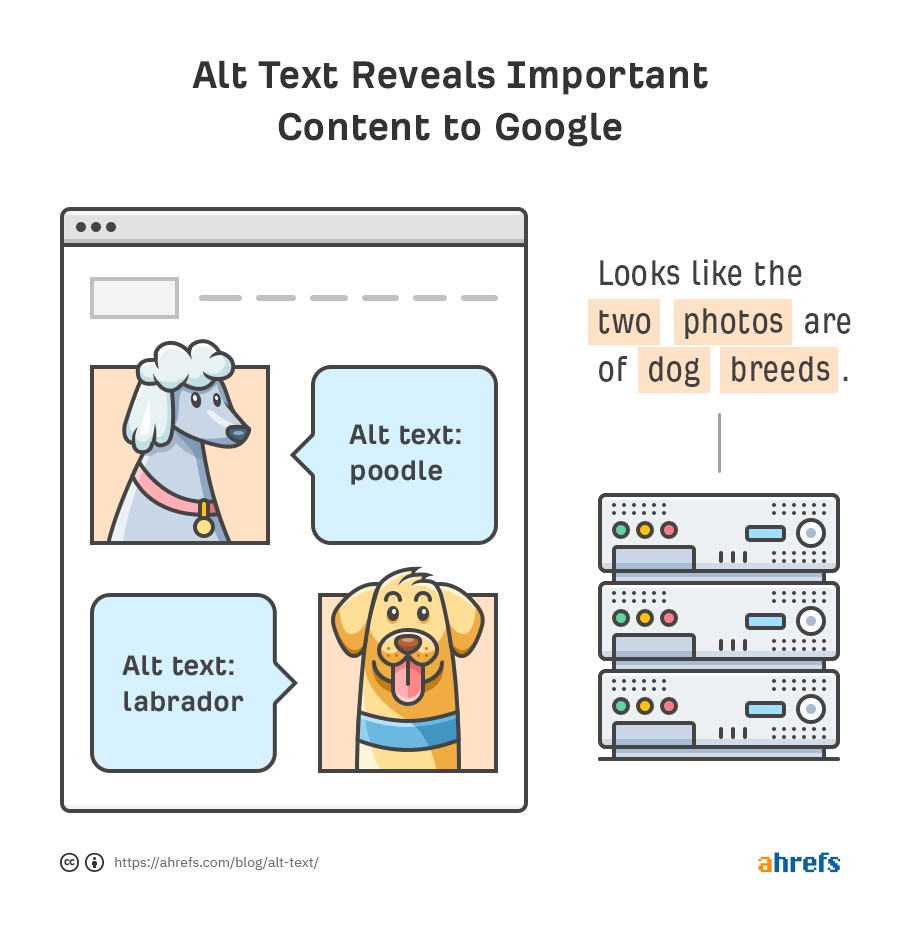
Don’t forget to optimize your visuals. Webpages with 7 or more images get 116% more organic traffic.
The digital health platform ZOE saw significant organic growth (754% in 6 months) partly by optimizing their images with descriptive alt text and filenames, earning them over 72,000 image snippets in search results.
Search engines can’t “see” images like humans do, so you need to provide context:
- Use descriptive file names that include keywords like “
creative-seo-writing-tips.png”instead of generic names like “IMG_001.jpg.” - Write descriptive alt text for each image, incorporating keywords naturally where relevant. Alt text helps search engines understand the image and is crucial for accessibility (screen readers use it).
To make this clearer, let’s look at how forced keyword use compares to natural integration.
Natural vs. Forced Keyword Integration
| Keyword | Forced/Awkward Usage | Natural/Smooth Usage |
|---|---|---|
| Best vacuum cleaner | “Looking for the best vacuum cleaner? Our best vacuum cleaner is the best vacuum cleaner for pet hair. Buy the best vacuum cleaner today!” | “Choosing the best vacuum cleaner depends on your home. Do you need powerful suction for pet hair, or a lightweight model for stairs? Let’s explore top-rated options.” |
| Cloud computing solutions | “We offer cloud computing solutions. Our cloud computing solutions provide scalable cloud computing solutions for your business.” | “Explore our enterprise cloud features for scalable performance. These cloud-based services adapt as your business grows, offering flexible computing solutions.” |
| SEO writing tips | “Get SEO writing tips here. These SEO writing tips improve SEO writing. Use our SEO writing tips for better SEO writing.” | “Need effective SEO writing tips? This guide covers keyword integration, readability, and how to craft content that ranks well and engages readers.” |
See the difference? Natural integration flows better and focuses on providing value, while forced usage sounds repetitive and spammy.
If using the exact keyword phrase sounds unnatural, you can also use synonyms and related terms. Using variations like “content optimization techniques,” “writing for search engines,” or “creative SEO strategies” instead of just “SEO-friendly creative content” keeps your language fresh and provides broader semantic signals to Google.
Keyword placement is important, but it’s only part of the puzzle. How you structure and format the entire piece plays a huge role in keeping both readers and search engine bots happy.
Good Structure and Formatting for Bots and People

Think about the last time you landed on a webpage that was just a giant wall of text. Did you read it, or did you go elsewhere for the info?
How your content looks and flows—content design—is just as important as what it says. Good structure and formatting make your content easy to read and digest for humans, which improves UX.
Luckily, the formatting elements that make content user-friendly also help search engine crawlers understand your content’s structure, hierarchy, and key points. It’s a win-win!
Use clear headings and subheadings

We already talked about headings in the context of keyword placement, but their primary role is structure. Use a clear heading hierarchy:
- H1: Your main title (only one per page).
- H2s: Major sections of your article.
- H3s (up to H6 if needed): Sub-points within those sections, which
- breaks up your content into digestible chunks,
- allows readers to scan for relevant information quickly, and
- tells search engines how your content is organized.
Well-structured content using headings logically improves readability scores and helps search engines parse the information effectively. Ensure your headings accurately describe the content that follows.
Write short paragraphs and sentences

Keep your paragraphs focused and brief, with no more than 4 sentences or lines each.
Shorter paragraphs are less intimidating and much easier to read, especially on mobile screens. Similarly, vary your sentence length but lean towards shorter, clearer sentences (averaging under 20 to 25 words is a good target).
Many readability formulas, like the Flesch-Kincaid Grade Level, penalize long sentences and paragraphs. Aim for a 7th-grade reading level or below to make your content accessible to a wider audience.
86% of users favor readable websites. Readability tools can help you measure the reading level.
Use bullet points and numbered lists
Whenever you’re listing items, steps, or key takeaways, use bullet points or numbered lists. Lists break up the visual monotony of paragraphs, make information highly scannable, and help readers digest complex information quickly.
Google frequently uses content formatted as lists (both bulleted and numbered) to generate Featured Snippets at the top of search results. Structuring key information in lists is a creative way to potentially capture this valuable SERP real estate.
Employ bold and italic text strategically
Use bold text or italics sparingly to emphasize key terms, definitions, or important phrases within your paragraphs. This helps guide the reader’s eye and makes the content easier to scan for crucial information. Don’t overdo it though, or the formatting loses its impact and makes the content harder to read.
It helps to create your own internal style guide for governance. For instance, you may want to bold takeaway sentences or put important terms in italics the first time you define them.
Beyond these specific elements, ensure your content flows logically from one section to the next. Start with an introduction that sets the stage, develop your main points with clear transitions, and end with a conclusion that summarizes the key message.
Visuals also play a critical role in structure and engagement.
Incorporate relevant images and infographics

Linkable assets like images, charts, screenshots, and infographics break up text, illustrate concepts, add visual appeal, and make complex information much easier to understand. Content with unique visual elements like diagrams and charts attract higher engagement than text-only content.
Ensure your visuals are high-quality, directly relevant to the surrounding text, and properly optimized with descriptive file names and alt text. Compressing images is also vital for page speed.
Websites with visual content get 94% more views and traffic than text-only pages.
Embed videos where appropriate
Videos are incredibly engaging and can significantly increase the amount of time visitors spend on your page.
Including video content on a page can increase organic search traffic by as much as 157%, and often leads to higher click-through rates compared to plain text results.
If it’s better to explain a concept visually so that your audience will understand it more easily, embed a relevant video. Make sure to optimize the video’s title and description as well.
Ensure your site is mobile-friendly

With over half of web traffic coming from smartphones and tablets, your content must look good and be easy to navigate on smaller screens. This means using a mobile-responsive design, ensuring text is readable without zooming in, and checking that buttons and links are easy to access on different devices.
Google uses mobile-first indexing, meaning it primarily looks at the mobile version of your site for ranking purposes. A poor mobile experience leads to high bounce rates and hurts your SEO.
Structure and formatting lay the groundwork for a positive UX, but to get the most impact, the words you choose need to resonate with your audience. So let’s talk about how to keep your unique writing voice alive (and creative) while still hitting those important SEO marks.
Writing Techniques That Boost SEO Without Killing Your Voice
This is where the magic happens—blending the art of writing with the science of SEO.
Think of SEO principles not as rigid rules that suffocate creativity, but as guidelines that help your brilliant writing get discovered. The key is to prioritize your reader and write naturally, then layer in optimization techniques thoughtfully.
Start with a compelling introduction

Your introduction is your first impression – make it count! Grab the reader’s attention immediately with a strong hook (use a relatable question, surprising statistic, or brief story).
Clearly introduce the topic or problem your content addresses and briefly state what the reader will gain by sticking around. Instead of a dry opening like, “This post will discuss creative SEO,” try something more engaging: “Tired of choosing between writing content you love and content that ranks? What if you could do both? This guide explores practical ways to inject your creative spark into SEO writing.”
Don’t forget to naturally weave your primary keyword into this opening paragraph to signal relevance right away.
Write naturally and authentically

Above all, write for the humans who will be reading your content. Use language that feels natural to you and resonates with your target audience.
Readers (and increasingly, algorithms) can often detect content that feels forced, overly optimized, or purely AI-generated without a human touch. So don’t try to force keywords or sentence structures that feel awkward or unlike you.
Let your unique perspective and personality shine through. Your unique, genuine voice and experience are the differentiators in a crowded market, and that authenticity builds trust and connection, which aligns perfectly with Google’s emphasis on E-E-A-T.
Write in a conversational tone

Imagine you’re explaining your topic to a friend. Writing in a conversational tone – using “you,” asking questions, incorporating contractions (like “you’re” or “it’s”), and keeping the language approachable makes your content feel more personal and easier to read. This style naturally aligns with how people search using voice assistants, and helps search engines understand the context through natural language processing (NLP).
Conversational writing often naturally includes the long-tail keywords and question-based phrases that are vital for modern SEO, especially voice search. Plus, it enhances UX, a known ranking factor.
Use active voice for clarity and impact
Whenever possible, use active voice (“The writer crafted the sentence”) rather than passive voice (“The sentence was crafted by the writer”). Active voice is more direct, concise, energetic, and easier to understand. It makes your writing feel more confident and engaging.
Readability tools flag passive voice. Using passive voice is fine on occasion, but aim to keep passive voice under 10% as suggested by Yoast) to improve clarity, readability and flow.
Incorporate storytelling to engage and rank

Humans are wired for stories. Weaving narratives, personal anecdotes, relatable examples, or compelling case studies into your content makes it far more engaging and memorable.
Stories capture attention, evoke emotion, and can dramatically increase the time readers spend on your page (dwell time), and reduce how often they bounce away immediately. These improved engagement metrics send positive signals to search engines, indirectly boosting your SEO.
A 2025 Digidop study suggested practical elements may outperform storytelling for immediate utility, storytelling excels at driving engagement metrics like time on page. The most effective content balances providing practical value quickly with engaging narrative elements.
Offer unique insights and value
What makes your content stand out? Go beyond rehashing information found elsewhere:
- Offer your unique perspective
- Share original data or research
- Provide expert tips based on your experience
- Tell stories that illustrate your points in a fresh way
Doing so provides E-E-A-T, makes your content more valuable to readers, and increases the likelihood it will be shared and linked to. Original research and content showcasing deep expertise are highly effective and can generate 40% more engagement.
Maintaining your creative voice while optimizing for SEO is achievable with these techniques. And thankfully, you don’t have to manage every single detail manually. There are some fantastic tools available to help streamline the process.
Tools That Support Both SEO and Creative Writing
Leveraging the right tools can make creating SEO-friendly creative content much smoother and more efficient. These tools can handle some of the more technical aspects of SEO, freeing up your mental energy to focus on the creative side – crafting compelling narratives, developing unique angles, and polishing your prose.
Keyword research tools

Keyword research tools like Semrush, Ahrefs, Moz Keyword Explorer, Google Keyword Planner, and Keywords Everywhere are essential for the audience insight phase. They help you:
- Find relevant keywords your audience is searching for.
- Analyze search volume (how many people search) and keyword difficulty (how hard it is to rank).
- Understand search intent (many tools now offer intent labels).
- Discover related terms, questions, and topic ideas.
Some tools like Keyword Insights or Surfer SEO even help group keywords into topic clusters.
You could use Semrush’s Keyword Magic Tool to find primary keywords for your topic, or its Topic Research tool to identify content gaps by analyzing competitors.
Content optimization tools

Once you have your topic and keywords, use tools like Surfer SEO, Clearscope or MarketMuse to help optimize your content for ranking. They typically work by analyzing the current top-ranking pages for your primary keyword and providing data-driven recommendations on the:
- Ideal content length
- Keywords and related terms (NLP terms) to include
- Content structure (the number of headings, paragraphs, images)
- Topics to cover to ensure comprehensiveness
- Readability scores
These are powerful tools, but be careful to only rely on these tools for guidance, not instructions. Over-optimizing based solely on tool recommendations can sometimes lead to content that sounds stiff and robotic. Always use your judgment to maintain your voice and prioritize the experience of your audience.
AI writing assistants

AI tools like ChatGPT, Jasper, Claude, Perplexity, Gemini, and Copy.ai can be incredibly helpful assistants in the creative process to:
- Brainstorm ideas and angles
- Generate outlines based on a topic or keyword
- Draft sections of content (introductions, conclusions, specific points)
- Rewrite sentences or paragraphs for clarity, tone, or conciseness
- Summarize research
- Check grammar and spelling
AI tools designed specifically for SEO (like Writesonic or SEO.AI) can often integrate keyword research and optimization suggestions directly into the writing workflow.
Use AI tools to enhance human creativity, not replace it. Studies show that AI-assisted content (human oversight and input) performs significantly better than purely AI-generated content. Although 86% of SEOs use AI, most top-ranking content still has little AI involvement.
Readability checkers

Readability tools like Hemingway App, Grammarly and Readable analyze your writing and provide feedback on its clarity and simplicity. They typically check:
- Sentence length and complexity
- Paragraph length
- Use of passive voice
- Complex or jargon-filled words
Overall readability score (often using metrics like Flesch Reading Ease or Flesch-Kincaid Grade Level). Using these tools helps ensure your creative writing is still accessible and easy for your target audience (and search engines) to understand, helping you hit that target 7th-grade reading level. Grammarly also offers tone detection to help maintain consistency.
I love the Hemingway App. When you paste your text there, it highlights sentences that are too long or complex, prompting you to simplify them for better readability and flow.
SEO plugins

If you use a content management system like WordPress, SEO plugins are invaluable. They provide real-time feedback directly within your writing interface on:
- Keyword usage and placement
- Title tag and meta description optimization
- Readability
- Internal linking
- Other on-page SEO factors. These plugins make it easier to check the essential SEO boxes as you write and edit
SEO plugins to try include Yoast SEO, Rank Math, and AIOSEO (All in One SEO). Yoast SEO includes specific checks for readability based on metrics like Flesch Reading Ease, sentence length, paragraph length, passive voice, and transition words.
When choosing tools, consider your budget, technical comfort level, and specific needs. Many offer free versions or trials, so you can experiment to find the ones that best complement your creative workflow.
Strike the Right Chord with SEO and Creativity
Finding the sweet spot between SEO requirements and your creative expression will help make your voice heard in the crowded online world. Don’t let perceived constraints of SEO dim your creative spark.
Embrace these techniques, leverage helpful tools, and start crafting content that resonates deeply with the people you want to reach, and watch your content climb search rankings. When you focus on creating high-quality, engaging, and helpful content that reflects your unique perspective, your content will naturally align with the core principles of good SEO. And your audience and the search engines will thank you for it.
References
2025 Digital Experience Benchmarks. Contentsquare. Retrieved from https://go.contentsquare.com/en/digital-experience-benchmark
6 Types of Content That Attract Backlinks. Digital SEO Land. Retrieved from https://digitalseoland.com/blog/linkable-content-types-that-attracts-backlinks/
Alves, L. (2025). 15 of the Best Readability Scoring and Checker Tools (2025). Search Atlas. Retrieved from https://searchatlas.com/blog/readability-tools/
Balancing SEO and Readability — An Editor’s Perspective. (2025). Blueleaf Editing. Retrieved from https://blueleafediting.com/balancing-seo-and-readability-an-editors-perspective/
Bleeding Edge. (n.d.). A Complete Guide to Search Intent & AI: Winning the Search Game in 2025. BleedingEdge.tv. Retrieved from https://bleedingedge.tv/a-complete-guide-to-search-intent-ai-winning-the-search-game-in-2025/
D., S. (2025). 18 SEO Case Studies from First-Person Accounts. Surfer SEO. Retrieved from https://surferseo.com/blog/seo-case-studies/
Dean, B. (2025). Google’s 200 Ranking Factors: The Complete List. Backlinko. Retrieved from https://backlinko.com/google-ranking-factors
Dean, B. (2025). Search Intent: The Definitive Guide. Backlinko SEO Hub. Retrieved from https://backlinko.com/hub/seo/search-intent
Dean, B. (2025). Here’s What We Learned About Organic Click Through Rate. Backlinko. Retrieved from https://backlinko.com/google-ctr-stats
Dean, B. (n.d.). 74 Important SEO Statistics for 2025. Backlinko. Retrieved from https://backlinko.com/seo-stats
Drexler, O. (2024). The Ultimate Keyword Research Guide [EASY WAY]. Mayple. Retrieved from https://www.mayple.com/resources/digital-marketing/keyword-research
Emperado, M. L. G. (2025). Top 30 SEO Statistics 2025: Key Trends and Insights to Optimize Your Search Strategy. DesignRush. Retrieved from https://www.designrush.com/agency/search-engine-optimization/trends/seo-statistics
Envisionit Agency. (2025). SEO metrics that matter: Ditch the outdated and track these instead. Envisionit Agency. Retrieved from https://envisionitagency.com/blog/envisionitagency-com-blog-seo-metrics-that-matter/
Deda, Y. (2025). 150+ Crucial SEO & Marketing Stats for 2025. SE Ranking. Retrieved by https://seranking.com/blog/seo-statistics/
Fishkin, R. (2024). New Research: We analyzed 332 million queries over 21 months to uncover never-before-published data on how people use Google. SparkToro. Retrieved from https://sparktoro.com/blog/new-research-we-analyzed-332-million-queries-over-21-months-to-uncover-never-before-published-data-on-how-people-use-google
Greenlane Marketing. (n.d.). User Intent in SEO: A Practical Guide for 2024. GreenlaneMarketing.com. Retrieved from https://www.greenlanemarketing.com/resources/articles/user-intent-seo
Greesonboch, S. (n.d.) How to Start and How to Finish: Intros and Conclusions. Retrieved from https://b2bwritinginstitute.com/how-to-start-and-how-to-finish-intros-and-conclusions/
How a Nutrition App Grew Site Traffic by 754% in 6 Months. AIOSEO. Retrieved from https://aioseo.com/trends/zoe-seo-case-study/
How to structure content for better readability and SEO in 2024? JEMSU. Retrieved from https://jemsu.com/how-to-structure-content-for-better-readability-and-seo-in-2024/
Ichir, L. (2022). Leverage Synonyms in your SEO Content Strategy. Topicseed. Retrieved from https://topicseed.com/blog/synonyms-seo/
Ineza, O. (n.d.). Why Keyword Research is Still Important for ASO in 2025. RPLG.io. Retrieved from https://rplg.io/why-app-keyword-research-is-important-for-aso/
Jeske, S. (2024). Enhancing Your Content Strategy with SEO Best Practices. MarketMuse. Retrieved from https://blog.marketmuse.com/enhancing-your-content-strategy-with-seo-best-practices/
Jhean, G. (2025). 19 SEO Case Studies: Strategies That Work in 2025. All in One SEO. Retrieved from https://aioseo.com/seo-case-studies/
Jhean, G. (2025). 83 SEO Statistics for 2025 (Current & Verified). AIOSEO.com. Retrieved from https://aioseo.com/seo-statistics
Kaatz, J. (n.d.) Is Readability Important For SEO? Illumination Marketing. Retrieved from https://www.marketingillumination.com/blogs/readability-important-for-seo
Lunn, M. (n.d.). The Ultimate Guide to Keyword Research in 2025. LeadPoint Digital. Retrieved from https://www.leadpointdigital.com/the-ultimate-guide-to-keyword-research-in-2025/
Mahale, N. (2025). What is Search Intent? Types, Examples & How to Optimize. Writesonic. Retrieved from https://writesonic.com/blog/what-is-search-intent
McKenzie, L. (2025). The Complete SEO Checklist. Backlinko. Retrieved from https://backlinko.com/seo-checklist/
Mortensen, O. (2025). 6 Tips on How to Avoid Keyword Stuffing in 2025 [That Actually Work]. SEO.ai. Retrieved from https://seo.ai/blog/how-to-avoid-keyword-stuffing
Moz. (2024). Search Intent: Understand What Searchers Want. Moz Learn SEO. Retrieved from https://moz.com/learn/seo/search-intent
Murton Beets, L. (2024). 57+ Content Marketing Statistics to Help You Succeed in 2025. Content Marketing Institute. Retrieved from https://contentmarketinginstitute.com/content-marketing-strategy/content-marketing-statistics
Ogilvy. (2025). Social Trends 2025: Social-First Brand Building & Key Shifts for 2025. Ogilvy.com. Retrieved from https://www.ogilvy.com/ideas/social-trends-2025-social-first-brand-building-key-shifts-2025/
Optimizing Content with Keyword Clustering for SEO in 2025 [Tips + Tools + Examples]. SlamMediaLab.com. Retrieved from https://www.slammedialab.com/post/keyword-clustering
Pandey, S. (2020). Semantic SEO Guide 2025: Optimizing for Topics & Entities. NiuMatrix.com. Retrieved from https://niumatrix.com/semantic-seo-guide/
Patel, N. (n.d.). Search Engine Trends for 2024. NeilPatel.com. Retrieved from https://neilpatel.com/blog/search-engine-trends/
Rose-Collins, F. (2025). Visual Storytelling in SEO: How Infographics & Slides Improve User Engagement and Rankings. Ranktracker. Retrieved from https://www.ranktracker.com/blog/visual-storytelling-in-seo-how-infographics-slides-improve-user-engagement-and-rankings/
S., M. (2025). 18 Tips to Write SEO-Friendly Content That Ranks in 2025. Hostinger. Retrieved from https://www.hostinger.com/tutorials/write-seo-friendly-content
Search Engine Land. (n.d.). Your 2025 playbook for AI-powered cross-channel brand visibility. SearchEngineLand.com. Retrieved from https://searchengineland.com/your-2025-playbook-for-ai-powered-cross-channel-brand-visibility-454026
SEO Statistics That Prove Its Effectiveness in 2023. (2023). Markitors. Retrieved from https://markitors.com/seo-statistics-that-prove-its-effectiveness-in-2023/
SEO Trends 2025: 20 Stats to Boost Your Search Rankings. (2025). Digidop. Retrieved from https://www.digidop.com/blog/seo-trends-2025-20-stats
User Intent in SEO: Understanding the “Why” Behind the Search. (n.d.). seoClarity. Retrieved from https://www.seoclarity.net/blog/user-intent-seo
What Is Search Intent? + How It Shapes Content Strategy. (2025). SiegeMedia. Retrieved from https://www.siegemedia.com/seo/search-intent
Shepard, C. (2023). Google Rewrites 61% of Page Title Tags [SEO Study]. Zyppy SEO. Retrieved from https://zyppy.com/seo/title-tags/google-title-rewrite-study/
Spera, M. (2022). The Only 12 SEO Best Practices You Need to Know [2025 Checklist]. GrowthMarketingPro. Retrieved from https://www.growthmarketingpro.com/seo-best-practices-checklist/
Super, S. (2024). Keyword Integration: A Comprehensive Guide For SEO Success. Linkbot Library. Retrieved from https://library.linkbot.com/keyword-integration/
Super, S. (2024). What Is the Significance of Meta Descriptions for SEO? Linkbot Library. Retrieved from https://library.linkbot.com/what-is-the-significance-of-meta-descriptions-for-seo/
Tallwave. (n.d.). SEO in 2024: Riding the Wave of Change. Tallwave.com. Retrieved from https://tallwave.com/blog/seo-in-2024/
Tanguay, A. (2024). Topic clusters and SEO: Everything you need to know in 2025. Search Engine Land. Retrieved from https://searchengineland.com/topic-clusters-and-seo-everything-you-need-to-know-in-2025-448378
The Complete Guide to Optimized Content for SEO in 2025. (2024). The AD Firm. Retrieved from https://www.theadfirm.net/the-complete-guide-to-optimized-content-for-seo-in-2025/
The Power of Storytelling in SEO: How to Engage and Rank Higher. (2025). Content Whale. Retrieved from https://content-whale.com/us/blog/power-of-storytelling-in-seo/
Zarudnyi, A. (2024). Keyword Stuffing: Definition, Examples & How to Avoid It. SE Ranking. Retrieved from https://seranking.com/blog/keyword-stuffing/




